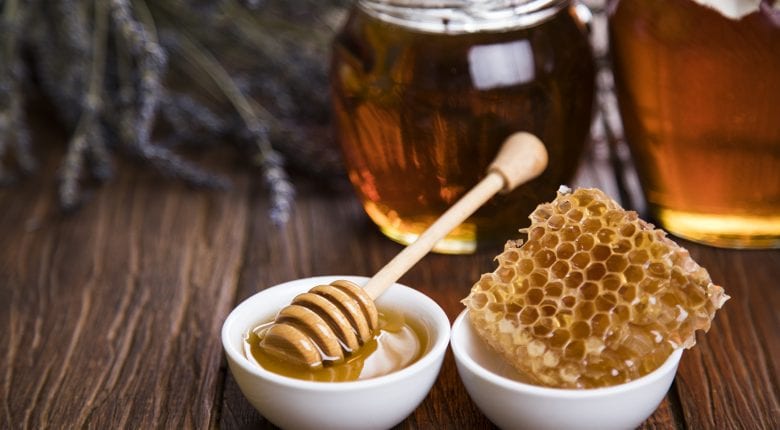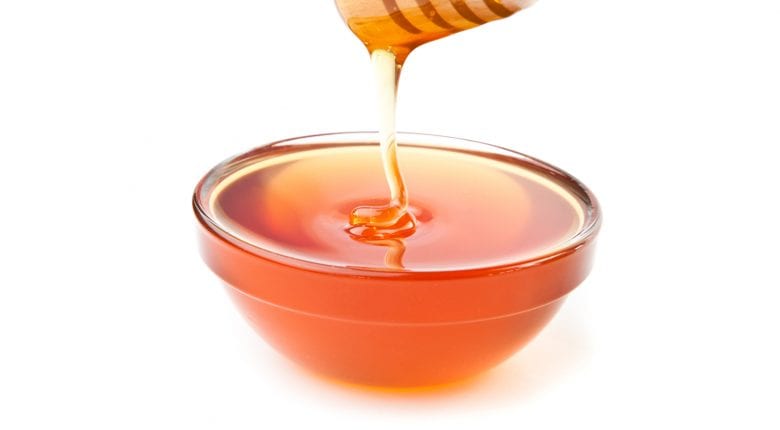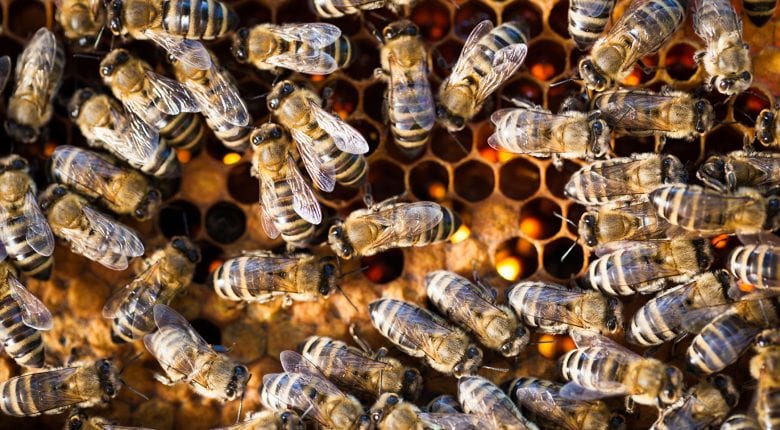Delicious or should we say Bee-licious! Whether on a roll for breakfast or as a sweetener for tea, honey is incredibly versatile. However, the kitchen is not the only place where this natural product is hugely popular. This article tells you how else you can use honey, whether it’s healthier than refined sugar and how it is made.
What happens when a bee makes the flight and collects nectar, secretions from living parts of plants or even excretions from insects sucking on plants? Well, this is where honey production begins. However, both the bees and the beekeepers have a lot of work to do before we can spread the finished honey on our rolls.

From bee to the jar – what happens?
Once the bees have collected this raw material with their proboscis and ingested it via the oesophagus into their honey stomach, they fly back to the beehive. This is where there are other ‘processor’ bees which are responsible for taking in the harvest. The process of honey ripening begins. The processor bees withdraw water from the unfinished honey and enrich it with enzymes and other substances from their saliva, and then pass it on to other bees. As part of this process, the disaccharide sucrose is turned into the simple monosaccharides of fructose and glucose.
The process of passing on the honey from bee to bee ripens the sweet juice more and more until it is finally stored in the honeycomb by the last bee in the “chain”. Here the warm climate and active ventilation by the bees causes the honey to dry. When the honey is dry enough, the bees cap the honeycomb with wax. This not only preserves the honey but it is also securely sealed, ensuring it keeps throughout the winter months.
Capped honeycomb is, therefore, an indication to the beekeeper that the honey is ripe. The harvesting of unripe honey containing too much water would lead to fermentation and rapid spoilage. When harvesting, the beekeeper removes the honeycomb and “uncaps” it. Spinning, sieving and stirring then create the fine crystalline creamy honey, which is poured into jars and which we are then able to buy.
Lots of varieties – lots of tastes
When purchasing honey, the customer has more than 50 different varieties to choose from. But how do these come about and which varieties best suit our tastes? The reason for this variety is the so-called flower constancy of the bees. This means that the same bee only visits one species of plant. As a result, honey varieties differ in their botanical origin and have variety-specific properties in terms of colour, consistency and flavour.
The connections between these properties also make it possible to infer information about the flavour from the colour. In general, the lighter the honey, the sweeter and milder the taste. By contrast, darker honey tastes more full-bodied and less sweet. The consistency depends on the dextrose content. A higher dextrose content gives a thicker consistency, and in runnier honey varieties the dextrose content is lower.

Is honey healthier than refined sugar?
This question arises when seeking alternatives to refined sugar which is detrimental to health in large quantities. When answering this question, it is helpful to take a look at the composition of sugar and honey. Refined sugar is nothing more than pure sucrose, in other words, the disaccharide comprised of equal proportions of the monosaccharides glucose and fructose. The composition of honey is slightly more complex.
In honey, fructose and glucose are already present in their individual forms as a result of the conversion which takes place during the honey maturing process. However, the content of fructose in the final honey is greater than the glucose content. For example, fructose makes up approximately 39% and glucose 34%. The remainder consists of water, other types of sugars and – in very low quantities – vitamins, minerals and other substances beneficial to health. So far, so good.
For the most part however, honey is still made up of sugar and the adage “the dose makes the poison” also applies in this case. However, the increased proportion of fructose does deliver a slight advantage. This is the reason why honey has a greater sweetness compared to refined sugar. You can, therefore, use slightly less for the same amount of sweetness and in turn, reduce the number of calories. The water content also means that one gram of honey contains only around three kilocalories in contrast to pure refined sugar which contains four kilocalories.
Antioxidant properties are also attributed to honey; these are said to reduce the risk of cardiovascular diseases and cancer. The content of substances beneficial to health is so low however that no notable contribution is made in terms of health benefits or towards covering our requirements. Instead, it’s a diet rich in fruit and vegetables which makes a significant contribution to this.
The high sugar content also means that unwanted effects detrimental to health are possible due to the pyrrolizidine alkaloids honey contains. The pyrrolizidine alkaloids are however not necessarily contained. At average levels of consumption, adults do not need to be concerned due to the minimal amounts of these in honey. Regularly changing honey varieties also cuts down the risk of absorption. For this reason, however, among others, honey consumption for babies and children should be kept to an absolute minimum.
Honey is unsuitable for children under the age of 1 in any case as there is the risk of triggering infant botulism due to the bacteria clostridium botulinum. The bacteria can multiply in the gut of small children and form harmful substances which then trigger botulism. So great care needs to be taken!
Alternative use – honey as a household remedy
Honey was highly prized even among the ancient Greeks and was used as a medicinal substance and a beauty treatment. Its use was popular when caring for lips and skin for example. It’s curative and wound healing properties are also well known. However, this has only been scientifically proven for very specific varieties such as manuka honey. In this case, it’s also essential that sterile medical honey from the chemist is used and not normal honey from the food retailer.
We’ve all been there: you have a sore throat, a runny nose and you’ll be coughing any time soon. When you’re suffering from colds and flu, all household remedies are very welcome. When combined with a hot drink, honey is also thought to provide a remedy. While this effect is not scientifically proven, it’s worth giving a try. To preserve potential beneficial substances, however, the honey should not be heated beyond 40°C.

Royal jelly – a new trend?
You may already have heard of the new magic cure which promises to deliver anti-ageing effects and alleviate rheumatism and allergies. This trend has, however, been subject to very little research and it is primarily based on speculation that the royal jelly, actually intended for the queen bee throughout her life, might have similar effects on people.
Royal jelly is available in the form of dietary supplements or mixed with traditional honey. Even though it is intended to help with allergies, royal jelly also has a high allergy potential and should, therefore, be avoided at all costs by asthmatics and people who have an allergic reaction to bee stings.
How it is extracted must also be carefully considered. The queen needs to be removed from her colony so that the sort-after “royal jelly” is made available for breeding a new queen. However, this causes a lot of stress for the bee colony. The products also come mainly from Asia and organic products are not yet available. As in the case of honey, contamination with pyrrolizidine alkaloids and residues of medicines and pesticides may also be present and you may, therefore, do more harm than good to your health.
The finest of the fine. High-quality honey!
Looking to buy not just any honey, but honey of particularly high quality? An even, fine crystalline and spreadable consistency together with the typical smell and taste of honey, free of foreign odours and flavours, are an indication of good quality. Dark spots on the other hand are a sign of contamination.
Honey is known for its very long shelf life. If kept in a dark, dry, cool place in an airtight container, it basically will not go off. However, consumption within two years is recommended. If not properly sealed, the honey absorbs moisture from the air. Too much moisture in the honey results in fermentation and then spoilage. The acidic alcoholic odour and the formation of bubbles, however, make this easy to notice.
Considerate extraction of the honey, treating the bee colonies with care and the use of sustainable, recyclable and reusable jars contribute to animal welfare and environmental protection and are all hallmarks of good honey. By buying directly from the beekeeper or at weekly markets, and using the origin information on the label, you can also be sure that your product has not been imported over long distances. It is certainly worth investing in good quality, and not just for the sake of flavour.
Did you know that after cattle and pigs, bees are the third most important form of livestock? The bee is hugely important for the preservation of biodiversity and species diversity of plants and plant-eating animals and also for maintaining crop yields and food supply. The fact bees are dying, which is caused among other things by pesticides and monocultures, is, therefore, a huge problem. Other product decisions made with sustainability in mind will therefore also impact positively on bee populations.